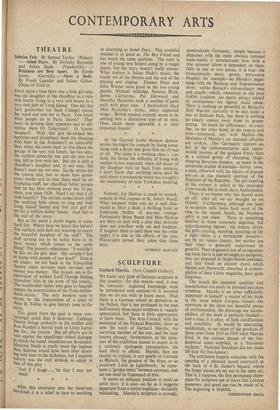SCULPTURE
Gerhard Marcks. (Arts Council Gallery).
WE know very little of German sculpture in this country; for this reason—and, it may be, correctly: neglected knowledge must be introduced with caution—it is assumed that we do not wish to know more. That there is a German school as distinctive as the Italian, that it has produced in the past half-century three major sculptors is vaguely appreciated, but there is little opportunity to learn more. The Arts Council, with the assistance of the Federal Republic, show us now the work of Gerhard Marcks, the surviving member of the trio, and the least known abroad; furthermore, as the spon- sors of the exhibition hasten to assure us in a curiously apologetic introduction, the least likely to offend. Marcks, they are careful to explain, is not nearly so German as Barlach, the greatest of the three, or so , positively Latin as Lehmbruch; he repre- sents a 'golden mean' between extremes, and no one need be frightened of him.
It seems an unhappy position to push an artist into; it is also—so far as it suggests departure from a native tradition—decidedly misleading, Marcks's sculpture is strongly,
unmistakably Germanic; simply because it dispenses with the more obvious national trade-marks it demonstrates how little a true national idiom is dependent on them. Only in one or two pieces, it is true—the tremendously stern, gaunt, terra-cotta Prophet, for example—do Marcks's begin- nings with the Bauhaus and Expressionism show; unlike Barlach's extraordinary men' and angels—which, conceived in the pure Gothic tradition, are nearly always related to architecture---his figures stand alone. There is nothing so powerful as Barlach's Holy Warrior, currently to be seen under a tree in Holland Park, but there is nothing so clearly uneasy away from its proper setting. So much for differences; in every line, on the other hand, in the reserve and even—compared, say, with Maillol—the bleakness of Marcks's art national affinities are evident. His Germanity appears no less in the undemonstrative and monu- mental posture of the goddess Freya than in a stylised group of' clumping, thigh- slapping Bavarian dancers; as much in the admirable studies of animals—horses, cows, a cock, observed with the fidelity of peasant art—as in the masterly portrait of the President of the Republic. The girl kneeling in the embers is called in the catalogue Cenerentolp, but in truth she is Aschenputtel.
There i4 no reason why this should scare us off; after all, we are brought up on, Grimm. Furthermore, although our taste in sculpture stills looks back most of the time to the classic South, the Northern spirit is not alien. There is something familiar in those extremely dignified, but unforthcoming figures: the bronze Orion, the girls running, standing, squaring up for a fight—there is a formidable Amazon— are by no means clumsy, but neither are they what is generally understood by graceful. Their elegance is not of an ingratiat- ing kind, but it is one we ought to recognise; they are disposed in Anglo-Saxon attitudes, and they touch an ancient chord which Moore and Hepworth, absorbed in contem- plation of their Celtic megaliths, have quite forgotten.
The search for ancestral qualities and resemblances can easily be pursued into pure nonsense. Marcks is an artist sufficiently important in himself: a master of his trade in the sense which Gropius valued—the woodcuts in the show are beautiful pieces of craftsmanship, the drawings arc accom- plished, all the work is perfectly finished— and a man, it is clear, of both steadfastness and sensibility. (It would be interesting, incidentally, to see more of the products of those years from 1933 to 1945 when Marcks lived, in the curious phrase of the bio- graphical notes supplied, as a 'free-lance sculptor.' National Socialism did not make life easy for free-lances.) The exhibition happily coincides With the opening of a pleasant paved courtyard at the back of 4 St. James's Square, where the larger pieces are set out in the open air. This is, I suppose, the first permanent show- place for sculpture out of doors that London possesses, and good use can be made of it. The beginning is hopeful.
CHRISTOPHER SMALL


































 Previous page
Previous page